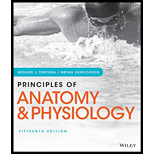
Principles of Anatomy and Physiology
15th Edition
ISBN: 9781119329398
Author: Gerard J Tortora, Bryan Derrickson
Publisher: John Wiley & Sons Inc
expand_more
expand_more
format_list_bulleted
Concept explainers
Question
Chapter 25, Problem 16CP
Summary Introduction
To review:
The principle catabolic events associated with fatty acids and glycerol.
Introduction:
Lipid catabolism is the process, through which the energy-rich bonds of lipid molecules are broken down. This process releases the chemical energy of lipids and uses this energy to facilitate the synthesis of adenosine triphosphate (ATP). Lipid molecules undergo the process of lipolysis to release the glycerol and fatty-acid molecules. These related molecules are further
Expert Solution & Answer
Want to see the full answer?
Check out a sample textbook solution
Students have asked these similar questions
What is the structure and function of Eukaryotic cells, including their organelles? How are Eukaryotic cells different than Prokaryotic cells, in terms of evolution which form of the cell might have came first? How do Eukaryotic cells become malignant (cancerous)?
What are the roles of DNA and proteins inside of the cell? What are the building blocks or molecular components of the DNA and proteins? How are proteins produced within the cell? What connection is there between DNA, proteins, and the cell cycle? What is the relationship between DNA, proteins, and Cancer?
Why cells go through various types of cell division and how eukaryotic cells control cell growth through the cell cycle control system?
Chapter 25 Solutions
Principles of Anatomy and Physiology
Ch. 25 - l. What is metabolism? Distinguish between...Ch. 25 - How does ATP link anabolism and catabolism?Ch. 25 - How is a hydride ion different from a hydrogen...Ch. 25 - 4. What are three ways that ATP can be generated?
Ch. 25 - How does glucose move into or out of body cells?Ch. 25 - Prob. 6CPCh. 25 - Prob. 7CPCh. 25 - Outline the principal events and outcomes of the...Ch. 25 - Prob. 9CPCh. 25 - Prob. 10CP
Ch. 25 - Prob. 11CPCh. 25 - Prob. 12CPCh. 25 - Prob. 13CPCh. 25 - Which lipoprotein particles contain "good" and...Ch. 25 - Prob. 15CPCh. 25 - Prob. 16CPCh. 25 - Prob. 17CPCh. 25 - Prob. 18CPCh. 25 - Prob. 19CPCh. 25 - Prob. 20CPCh. 25 - Prob. 21CPCh. 25 - Prob. 22CPCh. 25 - 23. What are the roles of insulin, glucagon,...Ch. 25 - Why is ketogenesis more significant during fasting...Ch. 25 - Prob. 25CPCh. 25 - Prob. 26CPCh. 25 - What are the functions of leptin, neuropeptide Y,...Ch. 25 - Prob. 28CPCh. 25 - Prob. 29CPCh. 25 - Prob. 30CPCh. 25 - 31. What is a nutrient?
Ch. 25 - Briefly describe the USDA's My Plate and give...Ch. 25 - What is a mineral? Briefly describe the functions...Ch. 25 - Prob. 34CPCh. 25 - Prob. 35CPCh. 25 - 1. Jane Doe's deceased body was found at her...Ch. 25 - During a recent physical, 55-year-old Glenn's...Ch. 25 - Marissa has joined a weight loss program. As part...
Knowledge Booster
Learn more about
Need a deep-dive on the concept behind this application? Look no further. Learn more about this topic, biology and related others by exploring similar questions and additional content below.Similar questions
- In one paragraph show how atoms and they're structure are related to the structure of dna and proteins. Talk about what atoms are. what they're made of, why chemical bonding is important to DNA?arrow_forwardWhat are the structure and properties of atoms and chemical bonds (especially how they relate to DNA and proteins).arrow_forwardThe Sentinel Cell: Nature’s Answer to Cancer?arrow_forward
- Molecular Biology Question You are working to characterize a novel protein in mice. Analysis shows that high levels of the primary transcript that codes for this protein are found in tissue from the brain, muscle, liver, and pancreas. However, an antibody that recognizes the C-terminal portion of the protein indicates that the protein is present in brain, muscle, and liver, but not in the pancreas. What is the most likely explanation for this result?arrow_forwardMolecular Biology Explain/discuss how “slow stop” and “quick/fast stop” mutants wereused to identify different protein involved in DNA replication in E. coli.arrow_forwardMolecular Biology Question A gene that codes for a protein was removed from a eukaryotic cell and inserted into a prokaryotic cell. Although the gene was successfully transcribed and translated, it produced a different protein than it produced in the eukaryotic cell. What is the most likely explanation?arrow_forward
- Molecular Biology LIST three characteristics of origins of replicationarrow_forwardMolecular Biology Question Please help. Thank you For E coli DNA polymerase III, give the structure and function of the b-clamp sub-complex. Describe how the structure of this sub-complex is important for it’s function.arrow_forwardMolecular Biology LIST three characteristics of DNA Polymerasesarrow_forward
arrow_back_ios
SEE MORE QUESTIONS
arrow_forward_ios
Recommended textbooks for you
 Human Physiology: From Cells to Systems (MindTap ...BiologyISBN:9781285866932Author:Lauralee SherwoodPublisher:Cengage Learning
Human Physiology: From Cells to Systems (MindTap ...BiologyISBN:9781285866932Author:Lauralee SherwoodPublisher:Cengage Learning Human Biology (MindTap Course List)BiologyISBN:9781305112100Author:Cecie Starr, Beverly McMillanPublisher:Cengage LearningHealth Safety And Nutrition F/Young ChildHealth & NutritionISBN:9781305144767Author:MAROTZPublisher:Cengage
Human Biology (MindTap Course List)BiologyISBN:9781305112100Author:Cecie Starr, Beverly McMillanPublisher:Cengage LearningHealth Safety And Nutrition F/Young ChildHealth & NutritionISBN:9781305144767Author:MAROTZPublisher:Cengage


Human Physiology: From Cells to Systems (MindTap ...
Biology
ISBN:9781285866932
Author:Lauralee Sherwood
Publisher:Cengage Learning


Human Biology (MindTap Course List)
Biology
ISBN:9781305112100
Author:Cecie Starr, Beverly McMillan
Publisher:Cengage Learning

Health Safety And Nutrition F/Young Child
Health & Nutrition
ISBN:9781305144767
Author:MAROTZ
Publisher:Cengage
